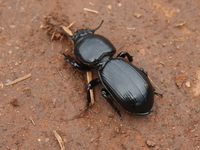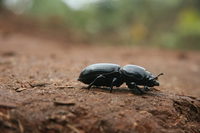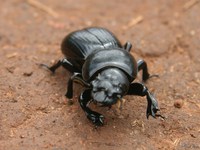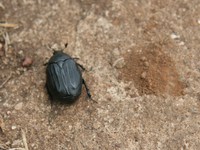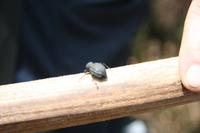beetles
The size of a dung beetle varies from species to species. The "dwellers" are usually small and elongate. Dung beetles are basically black, brown or purplish yellow in color; some are of metallic luster, especially the tropical species. Most dung beetles have a flattened, but stout body. The male of some species has horns at the head or thorax. Some dung beetles, other than the "dwellers", have strong, often "toothed" legs specialised for rolling dung and burrowing. The tarsi at the forelegs of an old dung beetle are usually damaged or lost owing to the labor of burrowing - some species do not have tarsi at the forelegs at all. The desert species also have hair on the legs which facilitates their movement on sand. Dung beetles have soft mouthparts suited to their diet.
Dung beetles live in many different habitats, including desert, farmland, forest, and grasslands. They do not like extremely cold or dry weather. They occur on all continents except Antarctica.
Dung beetles eat dung excreted by herbivores and omnivores, and prefer that produced by the former. Many of them also feed on mushrooms and decaying leaves and fruits. They do not need to eat or drink anything else because the dung provides all the necessary nutrients. The larvae feeds on the undigested plant fiber in the dung, while the adults do not eat solid food at all. Instead they use their mouthparts to squeeze and suck the juice from the manure, a liquid full of micro-organisms and other nutrients (as well as the body fluids from some unlucky animals such as dung-feeding maggots that sometimes get trapped between their mandibles).
Dung beetles (also known as tumble bugs) are beetles which feed partly or exclusively on feces. All of these species belong to the superfamily Scarabaeoidea; most of them to the subfamilies Scarabaeinae and Aphodiinae of the family Scarabaeidae. As most species of Scarabaeinae feed exclusively on feces, that subfamily is often dubbed true dung beetles. There are dung-feeding beetles which belong to other families, such as the Geotrupidae (the earth-boring dung beetle). The Scarabaeinae alone comprises more than 5,000 species.
Many dung beetles, known as rollers, are noted for rolling dung into spherical balls, which are used as a food source or brooding chambers. Other dung beetles, known as tunnellers, bury the dung wherever they find it. A third group, the dwellers, neither roll nor burrow: they simply live in manure.
Beetles are a group of insects which have the largest number of species. They are placed in the order Coleoptera, which means "sheathed wing" and contains more described species than in any other order in the animal kingdom, constituting about twenty-five percent of all known life-forms. Forty percent of all described insect species are beetles (about 350,000 species), and new species are frequently discovered. Estimates put the total number of species, described and undescribed, at between 5 and 8 million.
Beetles can be found in almost all habitats, but are not known to occur in the sea or in the polar regions. They interact with their ecosystems in several ways. They often feed on plants and fungi, break down animal and plant debris, and eat other invertebrates. Some species are prey of various animals including birds and mammals. Certain species are agricultural pests, such as the Colorado potato beetle Leptinotarsa decemlineata, the boll weevil Anthonomus grandis, the red flour beetle Tribolium castaneum, and the mungbean or cowpea beetle Callosobruchus maculatus, while other species of beetles are important controls of agricultural pests. For example, coccinellidae ("ladybirds" or "ladybugs") consume aphids, scale insects, thrips, and other plant-sucking insects that damage crops.

